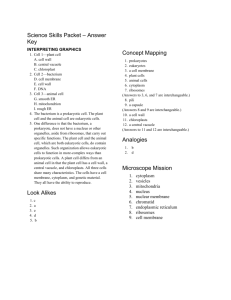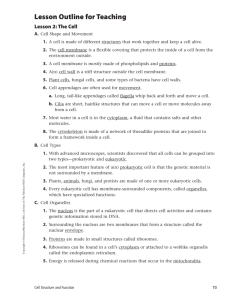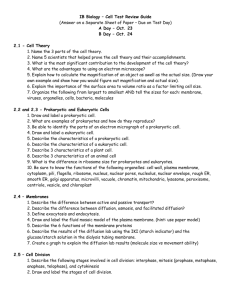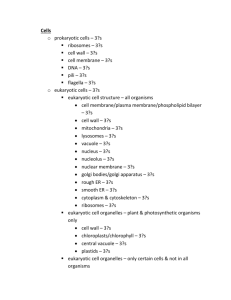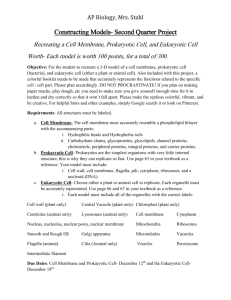Cells
advertisement
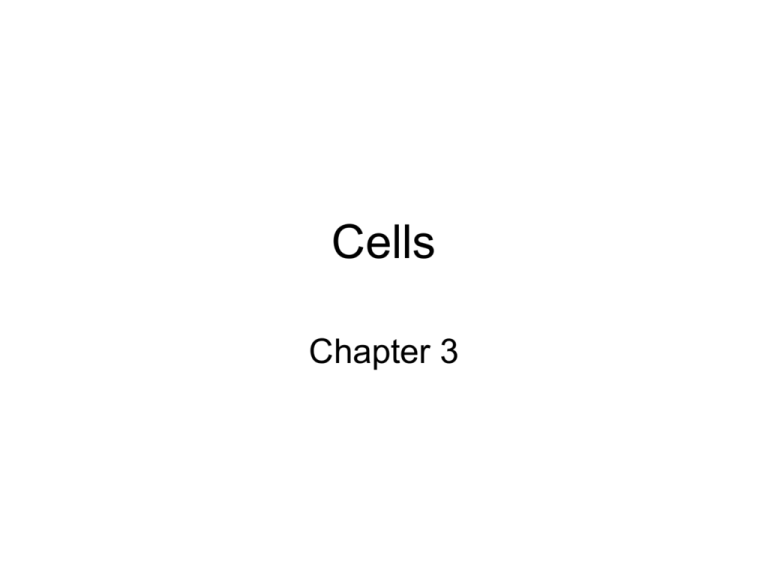
Cells Chapter 3 Early investigation of cells • Robert Hook, 1665, coined term “cells” after observing cork cells • Malpighi, Grew and Leeuwenhoek, late 1600’s described various plant tissues and Protistans • Jean Baptiste de Lamarck, all living things composed of cells • Robert Brown, 1831, discovered nuclei • Schleiden and Schwann, 1838-9, developed Cell Theory • Rudolf Virchow, 1858, argued against spontaneous generation • Louis Pasteur, 1862, demonstrated spontaneous generation did not occur Prokaryotic vs Eukaryotic • Prokaryotic – have no nuclei, or other membrane-bound organelles • Eukaryotic – possess both nuclei and other membrane-bound organelles • Domains Archaea and Bacteria, prokaryotic • Domain Eukarya, all eukaryotic includes Kingdoms Protista, Fungi, Plantae and Animalia Cell Structure • Protoplasm – all the material inside the cell wall • Cytoplasm – all the material between the plasma membrane and nucleus • Cytoplasm consists of the liquid cytosol and the organelles Cell Wall • primarily composed of cellulose • Middle Lamella – layer of pectin between two adjacent cell walls • Primary cell wall – laid down first, more flexible • Secondary cell wall – deposited inside primary, more rigid due to lignin • Plasmodesmata – strands of cytoplasm that extend through the cell walls of adjacent cells Plasma Membrane • outermost membrane surrounding cells • immediately inside cell wall • phospholipid bilayer with imbedded proteins, glycolipids and glycoproteins Nucleus • surrounded by nuclear envelope (membrane) • contains much of the cell’s DNA Chromatin – thin strands Chromosome – condensed, precedes cellular reproduction • Nucleoli, spherical structures in nucleus, consist of proteins and RNA; site of rRNA synthesis and ribosome subunit assembly Endoplasmic Reticulum • Rough ER – ribosomes present; site of protein synthesis, transport and storage • Smooth ER – site of lipid synthesis and transport Ribosomes • lack surrounding membrane • Present in prokaryotic and eukaryotic cells • site of protein synthesis Dictyosomes • aka Golgi Bodies in animal cells • receive, modify and package molecules Plastids • Chloroplast – site of photosynthesis • Chromoplasts – contain various pigments • Leucoplasts Amyloplasts – synthesize starch Elaioplasts – synthesize oils Chloroplasts • surrounded by a double membrane • contain some DNA and ribosomes • Grana – stacks of thylakoid membranes; contain chlorophyll; site of light-dependent reactions of photosynthesis • Stroma – liquid surrounding the grana; site of the light-independent reactions of photosynthesis Mitochondria • consist of an outer membrane and much in-folded (cristae) inner membrane • site of aerobic respiration • contains some DNA and ribosomes Endosymbiont Hypothesis • suggests chloroplasts and mitochondria were initially free-living, bacteria-like organisms that parasitized or were captured by early eukaryotic cells • supporting evidence – bacteria-like inner membranes – bacteria-like DNA – bacteria-like ribosomes Vacuoles • Central Vacuole – large, centrally located • storage site of various molecules • promotes rapid increase in volume of cell following cell reproduction Cytoskeleton • Microtubules – composed of protein; involved in cell wall formation, cell division, movement of cilia and flagella • Microfilaments – also protein, but thinner than microtubules; play a role in cytoplasmic streaming (cyclosis) Cell Reproduction • will be covered later
